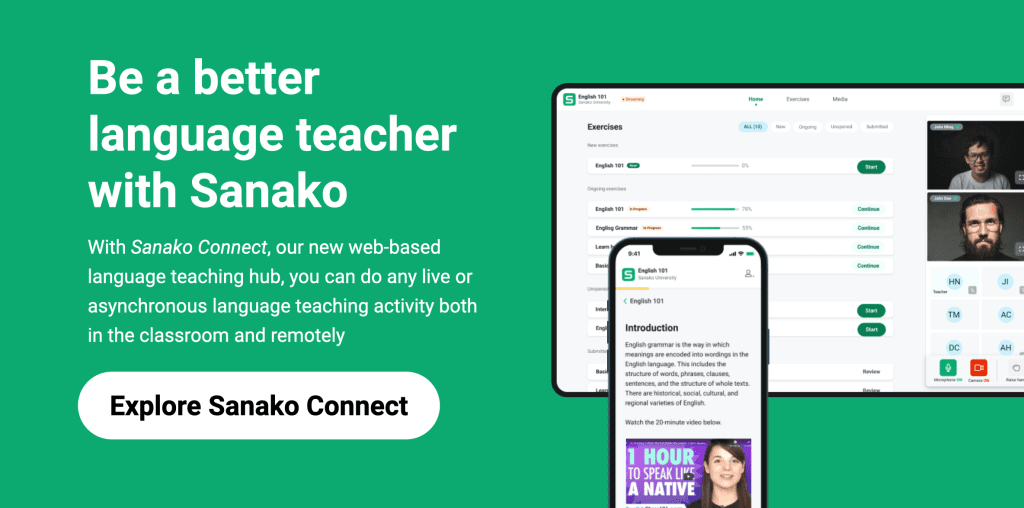It is perhaps the ultimate understatement to say that life as a teacher can be unpredictable! Every day, every lesson and every student is different, so it can be beneficial to plan and prepare for every eventuality. Controlling the controllables as a good life coach would say!
A key part of this for teachers, particularly at the beginning of their careers, is the use of a lesson plan to organise each student-facing session. This helps ensure that you’re as prepared as you can be and that you have a clear idea of what’s happening every time you step into the classroom.
Obviously each lesson plan will be different, but they’re formed upon common building blocks and teaching approaches. In previous blog posts we’ve looked at the ARC and PPP teaching approaches, so this blog post goes back to basics and highlights the 5 key parts of any great language lesson – around which a compelling lesson plan can be constructed.
Key components of a language lesson
After reviewing the literature and talking to our customers globally, it is clear that an effective lesson has five basic elements:
- Preparation
- Presentation/Modeling
- Practice
- Evaluation
- Expansion
Within this structure, every language lesson should clearly include an appropriate and wide variety of language learning activities focusing on language input and output. Such activities should also be carefully tailored to each student’s learning objectives / outcomes and should build on the knowledge and skills they already have.
1. Preparation
The beginning of every lesson is a key time for all educators. It’s the perfect opportunity to set the tone for what is to follow and so try to encourage a calm and orderly learning environment from the start.
Once all students are ready, begin by giving all students a clear idea of what the lesson’s key activities and learning objectives are. For some learners, it might be important that this is also clearly written on the board or on a slide to give them something to refer back to as the lesson progresses.
It may also be beneficial to start with a warm-up activity that gets students’ minds stimulated and ready to go – teaser questions can, for example, be a good way to trigger curiosity and create expectations. Similarly, get volunteers to provide a quick review of the last lesson / homework so that students see how this lesson builds on the last. Of course, beginning by clearing up any misconceptions or knowledge gaps can also help prepare learners for what is to come.
2. Presentation / Modeling
Having outlined the work to be completed, the lesson now moves into the presentation phase. Here the educator outlines the lesson’s intended learning content in a meaningful context or situation to their learners. Principally, this block provides the language input from the educator that provides a firm foundation, underpinning the learner’s understanding.
As such, it is important that educators deliver this content (or as much as practically possible) in the target language. Realia (e.g newspaper cuttings, household items, hobby materials), flashcards and miming are fun ways to present the language. Short audio or film clips can also be highly effective.
As a next step, students begin to practise their language output, which is carefully modelled upon the content / form that the educator has outlined. This work is designed to build comfort and familiarity in the concepts introduced. It is usually controlled by the teacher and learners practise saying or writing the language structure or vocabulary correctly. Teachers should certainly model and correct if mistakes occur.
Output activities might therefore include drills, gap-fill tasks, multiple choice exercises and directed conversation practice.
3. Practice
Having demonstrated a good level of understanding, students can now move onto completing a specific, designated communication task. This stage should be focused on encouraging students to use the target language as much and as fluently as possible to build their confidence and motivation. Students will typically work in pairs or small groups.
It is important in this stage that students are encouraged and motivated to participate. Games and role-plays encourage students to think on their feet and help recreate real-world scenarios in which students can use their language skills. Collaborative communication tasks (e.g writing and delivering presentations, debates etc) can also be highly effective.
4. Evaluation
Once the required activities have been completed, it is important to assess progress and students’ understanding. Ask students to recap the work that they have undertaken and to explain how they used their newly-acquired skills to carry out the task.
This, of course, provides educators with an opportunity to address any misunderstandings as part of a summary of what has been covered. It also gives educators the chance to praise students for what they achieved in this lesson and to trail what students will be focusing on next time.
5. Expansion
As the name suggests, the expansion phase gives students the opportunity to extend their learning beyond the classroom walls. This might involve a specific homework task for students to complete in their own time ready for the next lesson. Or it could simply be to encourage them to continue their language learning through books, films and podcasts in their target language
How do Sanako products help educators through these 5 key stages?
Sanako produces a range of language teaching tools that help educators to improve their students’ core language skills. For example, our browser-based language teaching solution Sanako Connect supports educators across all stages of the core lesson structure outlined above.
PREPARATION – Students’ understanding of grammar concepts and key vocabulary can be tested by creating exercises and questions for them to answer through gap-fill and multiple-choice quizzes.
PRESENTATION / MODELING – Educators can create distinctive contexts and situations in Sanako Connect using a wide variety of easily uploadable stimulus materials including text files, PDFs, presentations, audio clips, video, and web pages. Teachers can also give live instructions even when using Sanako Connect in hybrid or remote teaching.
PRACTICE – Students can be easily divided into pairs or group discussions and be assigned role play and live discussion activities. Outputs and deliverables can be collected, and reviewed on the same platform.
EVALUATION – Educators can collect, review and give feedback on students’ work in real-time or asynchronously. Teachers can give feedback to their students individually or as a group via speech or text at any time.
EXPANSION – Students can easily access extension activities at any time and in any location. They simply click on a unique URL to find extra worksheets as well as reading lists, recommended podcasts or suggested film / video content.
If you’d like to find out more about how Sanako’s dedicated language teaching solutions could transform your approach to language teaching, please contact us now to arrange your FREE demo!

